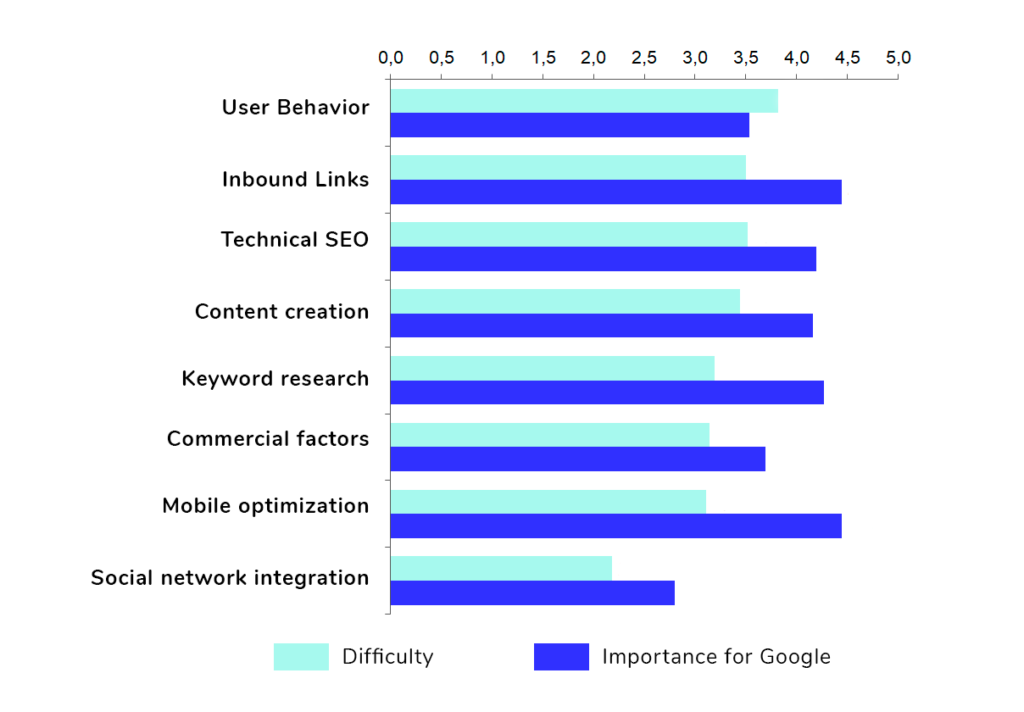Behavioral factors (BF) are indicators of a website that reflect its attractiveness, convenience, and utility: duration of stay on the site, depth of viewing, etc. Search engines (SE) carefully analyze how users behave on the site, and the better these metrics, the higher the site is rated.
Factors influence a large part of the sales funnel:
- On the positions — due to the long-term impact on Google.
- On attracting attention and traffic — through the development of the site’s snippet in search results.
- On conversion — due to a user-friendly interface and meaningful content.
There are two main groups of behavioral factors – On-Page and Off-Page. Off-Page tracks user actions before they reach the site. On-Page are those that occur within the resource.
Off-Page Behavioral Factors
- CTR (Click-Through Rate): The higher the percentage of users who click on a link out of all those who see it, the better. This takes into account not only the clickability of the title (title) of the snippet in the search results but also all links in it.
- Direct Entries: Search engines track how many users arrive at the site directly – from bookmarks or browser history hints. The higher the percentage of such transitions, the more useful and necessary the site is considered.
- Continuation of Search: If a user follows a link from a search engine to a site and then returns to the search results, it means they did not fully find what they were looking for. The more such users, the worse the site is in the eyes of Google.
- Site Traffic: The absolute number of users who visited the site over a period – a day or a month. The greater the total traffic of the site, taking into account all sources, the higher its chances of good ranking.
On-Page Behavioral Factors
- Viewing Depth: This is the number of site pages a user visits in one session. The more, the better.
- Bounces: An indicator that shows how often a user leaves the site immediately after entering it. For Google, “immediately” is within 1 second after entering. A high bounce rate indicates that users are dissatisfied with the site, and this affects negatively.
- Session Time: The total duration of one user session on the site. For search engines, spending a lot of time on the site is a plus. However, it’s important to note: if it’s a service site or an online store, a long session time is not always good. It may be difficult for users to find what they need, and this can be a signal of a poor interface or too “watery” content.
- Activity on the Site: Search engines track user actions: filling out forms, sharing content from the site on social networks, even cursor movements. The more such actions and the more diverse they are, the higher the trust in the site.
Factors Valued by Google
- Viewing Depth (number of viewed pages of the site).
- Total time spent on the site.
- Returns to search.
- Dwell time, or the length of the click. The same as the time spent on the site.
- Last clicks – the same as returns to the search results.

A site is considered high-quality if people spend enough time on it and do not leave immediately after visiting, interacting with it. Search engines collect data from various sources – search results, statistics systems – to consider all these factors when ranking sites. At the same time, the greatest influence on behavioral factors is exerted by transitions by frequent queries, as the signals there are most explicit.
General Recommendations for Google
- Increase the quantity and quality of content. In addition to text, you should add animated images and videos – their viewing increases the duration of stay on the site. Usually, users value such content more.
- Think about how to better interlink the site so that users can move around more comfortably and visit more pages. Use breadcrumbs. The other search engines services will help you more accurately select associative queries, and metrics and Webvisor will show how exactly users move around the site.
- Invest efforts and resources in web development and design. Interactive elements, such as a cost calculator or service designer, allow you to retain the user on the page and also increase conversion.
- Optimize the site. Part of the reason for returns to search is too slow site loading. The worse the loading speed, the higher the percentage of drop-off for this reason. Also, optimize the advertising. If the site is additionally monetized through advertising placement – you need to look at its quality and quantity. Perhaps, give up pop-up banners or adjust their display time.
- Motivate users to visit the site regularly, for example, by systematically updating and supplementing already published content. The higher the percentage of regular visitors, the greater the chances of making it to the top.
- Add a survey or poll on the site’s convenience page. While the user is writing a review or filling out a questionnaire, they will spend more time on the site. In addition, you will receive feedback, which is also very useful.
- Video is a content format that works well to improve behavioral factors. Try placing short videos on pages with poor indicators for time spent, which will complement the content on the page. This is enough to keep the visitor on the page and influence the statistics on behavioral factors.
How to Improve Behavioral Factors Without Affecting Other Factors
Here we will list not just effective, but at the same time safe ways to improve behavioral factors.
Working on Off-Page Factors
- Traffic source diversity. Publish the site in directories and on mapping services, buy links on thematic forums and in social networks – use as many different traffic sources as possible. The more diverse they are, the higher the trust from search engines.
- Snippet development. Write an attractive title, add micro-markup and an attention-grabbing favicon. Ideally, find the text from which the search engine took the excerpt for the description and make it more interesting to the user.
Working on On-Page Factors
- Checking content relevance. The alpha and omega of working on behavioral factors. If a user, upon reaching a page, does not see an answer to their query – it makes no sense to work on all other factors.
- Work on loading speed. Google PageSpeed Insights is a free and quite indicative tool. Check at least key pages and reduce content loading time. Remember: user always has a choice of which site to find the necessary information. If one resource takes too long to load – most likely, the person will close it and look for another.
- Elimination of broken links. Must-have, if access to the site is not only available to you but also, for example, to the developer. A user who ends up on a non-existent page is almost certainly a lost user for you.
- Work on low-frequency queries. What do you think, which query is a user more inclined to study information more thoughtfully: “Asus laptop” or “Asus rog strix g15 laptop”? Of course, it can vary, but the general logic is this: the more specific the user formulates their query, the more information they are prepared to receive on the site. Of course, if this information is specific and relevant to the query.
- Adding media and multimedia content. Text was and remains an important way of conveying information – however, it is not the only one. Images, video presentations and reviews, 3D objects, interactive maps, calculators, tests, and games are your helpers in increasing the time spent on the site.
What Not to Use to Grow Behavioral Factors
The main temptation and danger in working on behavioral factors is their manipulation. There are many ways to manipulate – writing your own bot programs, renting already written ones, using exchanges where real users will “walk” around the site in the way you specify, etc.
Manipulating behavioral factors is a practice officially prohibited by Google. At the same time, it is important to understand that the algorithms for protecting against manipulation are constantly improving. Even if you have come up with or bought an innovative way of manipulation and see only solid benefits – sooner or later your site will go far beyond the top 10 when the search engines find out about this method. And they will find out, and they will do it without warning.



